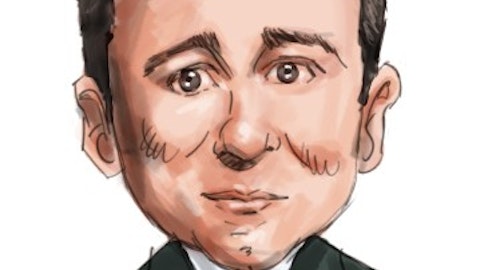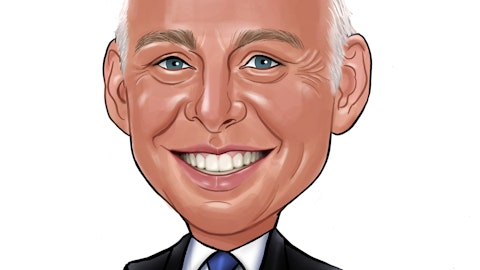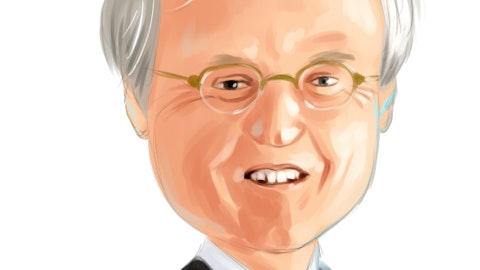Umpqua Holdings Corporation (NASDAQ:UMPQ) Q4 2022 Earnings Call Transcript January 24, 2023
Operator: Good morning, and welcome to the Umpqua Holdings Corporation’s Fourth Quarter 2022 Earnings Call. At this time, all participants are in a listen-only mode. After the speakers’ presentation, there’ll be a question-and-answer session. Please be advised that today’s conference is being recorded. At this time, I would like to introduce Jacque Bohlen, Investor Relations Director at Umpqua to begin the conference call.
Jacque Bohlen: Thank you, Catherine. Good morning, and good afternoon, everyone. Thank you for joining us today on our fourth quarter 2022 earnings call. With me this morning are Cort O’Haver, the President and CEO of Umpqua Holdings Corporation; Tory Nixon, President of Umpqua Bank; Ron Farnsworth, Chief Financial Officer; and Frank Namdar, Chief Credit Officer. After our prepared remarks, we will take questions. Yesterday afternoon, we issued an earnings release discussing our fourth quarter 2022 result. We have also prepared a slide presentation, which we will refer to during our remarks this morning. Both these materials can be found on our website at umpquabank.com in the Investor Relations section. During today’s call, we will make forward-looking statements which are subject to risks and uncertainties and are intended to be covered by the Safe Harbor provisions of federal securities law.
For a list of factors that may cause actual results to differ materially from expectations, please refer to Slides 2 and 3 of our earnings presentation as well as the disclosures contained within our SEC filings. We will also reference non-GAAP financial measures alongside our discussion of GAAP results. We encourage you to review the GAAP to non-GAAP reconciliation provided in the earnings presentation appendix. I will now turn the call over to Cort.
Cort O’Haver: Okay. Thank you, Jacque. For the fourth quarter, we reported earnings available to shareholders of $83 million. This represents EPS of $0.38 per share compared to the $0.39 reported last quarter and $0.41 reported in the fourth quarter of last year. On an operating basis, which excludes a number of interest-rate driven items and merger expenses that Ron will review, EPS of $0.46 compared to $0.47 last quarter and $0.44 in the fourth quarter of last year. For the variance between 2022 and 2021 fourth quarter EPS was minimal, the components shifted dramatically as higher interest rates and 16% loan growth during 2022 drove a 31% increase in net interest income, Q4 to Q4, leading to a 25% increase in pre-provision net revenue despite the dramatic decline in mortgage banking revenue.
Over the past year, we have made a number of structural changes within the mortgage banking segment, intended to reduce expenses, limit the impact of MSR changes to the income statement and moderate portfolio mortgage growth. Additional actions planned through this quarter will continue this work. Mortgages remain an important product for the bank and for our customers and we remain committed to serving our communities throughout the West. However, we are shifting our mortgage operations towards a retail bank model and we expect a smaller gross and net impact to financial statements and under our prior operating model. Turning now to our pending merger with Columbia Banking System. We announced earlier this month that we received FDIC approval and intend to close at the end of February.
Our teams are focused on closing and core system conversion scheduled for this quarter alongside a heightened level of customer outreach. We are laser-focused on execution and we look forward to providing you with an update on next quarter’s call when we are officially one team. As you know, there are a lot of moving parts over the next couple of months and our near-term focus is on achieving targeted cost savings, providing high-touch service to our customers as we complete the integration process and giving our teams and our associates the tools to drive the revenue synergy opportunities that we have been discussing for over a year now. Back in October of 2021, we never imagine there would be over 16 months between announcement and close.
However, there has also been significant upside to this timeline. We have been waiting but we have not been idle. The joint culture work, which was originally planned to occur post-closing has touched the majority of Umpqua associates and Columbia associates and it has set a framework that enables us to be one team on day one. The planning, prepping, and the brainstorming that has taken place over a year has enabled the development of synergistic products and tools and we are excited for our combined teams to use them immediately. Further and perhaps more importantly, the earlier decoupling of our integration planning from legal day one enable us to maintain our originally scheduled core conversion date this quarter, despite our targeted February 28 closing date.
I want to take this opportunity to thank our dedicated associates for the countless hours and incredible effort that they have put into their work. I’m impressed and humbled by your dedication. I joined Umpqua Bank at 2010 and have been honored to lead this outstanding organization for the past six years. While it may be bittersweet to pass the reins, I know I am placing them in capable hands. And as Executive Chair, I look forward to watching the combined organization service customers and it’s communities throughout the West of providing enhanced shareholder return. And with that, Ron, take it away.
Ron Farnsworth: Okay, thank you, Cort and for those on the call, I want to follow along. I’ll be referring to certain page numbers from our earnings presentation. Starting on Page 9 of the slide presentation, which contains our performance ratios both on a GAAP and operating basis. The adjustments to our internal operating measures include various fair value changes from interest rate volatility along with merger and exit disposal costs, which are detailed in the appendix on Slide 30. Our NIM continued to strengthen up 13 basis points in Q4 to 4.01%. Our GAAP PPNR ROAA was 1.82%, while our operating PPNR ROAA was 2.1% and operating ROTC increased to 16.2%. Turning to Page 10, which contains our summary of quarterly P&L. Our GAAP earnings for Q3 were $83 million or $0.38 per share.
On an operating basis, we earned $99 million or $0.46 per share. For the moving parts as compared to Q3, net interest income increased $17.9 million or 6% representing continued earning asset growth combined with the recent Fed rate increases. We had a provision for credit loss of $34.9 million with the increase driven primarily by slight deterioration in the consensus economic forecast. Noninterest income increased mainly related to changes in the nonoperating fair value marks as detailed later in the appendix and noninterest expense increased $17 million mainly from merger expense and nonrecurring increase in other expense. As for the balance sheet on Slide 11, loans were up $650 million and deposits increased $250 million. This difference, net of the decrease in spring cash was funded with short-term borrowings and the lift in investments AFS related primarily due to a lower unrealized loss.
Our total available liquidity including off balance sheet sources ended the quarter at $12 billion represent 38% of total assets and 44% of total deposits. As noted on the bottom of Slide 11, our tangible book value increased in part due to the lower AOCI rate mark on AFS investments. Slide 13 highlights net interest income building the increase to $306 million in Q4 resulted from the recent rate increases along with continued strong loan growth. From a rate volume standpoint, increase in rates led to $16 million of the $18 million increase with volume and mix, making up a $2 million difference. Following that, on Slide 14 of the presentation are the trends for our net interest margin. Again our NIM increased 13 basis points in total to 4.01% in Q4.
It represent a waterfall on the margin change on the right of the page, knowing that our loan and cash yields more than offset rising funding costs and key for me here is following the 125 basis point increase in the federal funds rate during Q4, our NIM for the month of December was 4.02%. The next slide includes information on the repricing and maturity characteristics of our loan portfolio noting no significant change in the repricing mix this past quarter. And following that, on Slide 16, on the upper left, we have included our projected net interest income sensitivity for future rate changes in both ramp and shock scenarios over two years. This is a simulation we run in back test quarterly and assumes a static balance sheet. The upper right shows our sensitivity from last quarter and comparing the two, even though we’ve taken steps this quarter to reduce sensitivity and will continue to do so in future quarters.

Photo by DocuSign on Unsplash
The deposit beta used in the current simulation is 53% on interest-bearing deposits for future rate changes. The table on the left shows our deposit betas from the current rising rate cycle while on the right we show them from the last rising rate cycle for comparison. Our beta then was 42% on interest-bearing deposits. Our cost of interest-bearing deposits increased from 23 basis points in Q3 to 77 basis points for Q4. Our cumulative data for this cycle to date is now 18% on interest-bearing deposits. The spot rate at year-end was 107 basis points. We expect interest-bearing deposit costs to increase again in Q1 but stay well below our model level. Next on Slide 17. We detailed our consolidated non-interest income trends, netting continued weakness within our mortgage banking segment was mostly offset by a positive fair value change on loans carried at fair value.
Turning to Slide 18 on expense. Majority of the increase this quarter related to merger expense for our upcoming combination with Columbia. In addition, we had an increase in state and local taxes along with other expense which I didn’t not view as recurring. The next two pages include the segment disclosures on a GAAP basis. The core banking segment on Slide 19 and the mortgage banking segment on Slide 20. The operating non-GAAP stats by segment are later on Slides 32 and 33. Suffice it to say the core banking segment continues to benefit from rising rates and continued loan growth, while Mortgage Banking reported a second consecutive quarterly loss. Cort mentioned plans underway earlier within Mortgage Banking. And a couple of final ones before I turn it over to Frank.
On Slide 22, we’ve included the quarterly loan balance roll forward. Quarterly loan growth was driven by $1.3 billion in new originations in net advances offset by $0.6 billion in payoffs and maturities. We’ve intentionally slowed down non-relationship lending production, given continued pressure with industry-wide deposit outflows following continued tightening by the Fed. Slides 23 and 24 provide additional statistics and composition on the portfolio and there is no significant changes in the quarter. Next, let me take your attention to Slide 25 on CECL and our allowance for credit loss. As a reminder, our CECL process incorporates a life of loan reasonable and supportable period for the economic forecast for all portfolios with the exception of C&I which is a 12-month reasonable and supportable period reverting gradually to the output mean thereafter.
We use the consensus economic forecast this quarter updated in November. Overall, the forecast reflected continued high expected inflation and interest rates with a slight uptick in peak unemployment rates. With this, we recognized a $32.9 million provision for credit loss with $7 million of that for the quarters’ loan growth and $26 million for the slightly deteriorating economic variables. This page shows the commercial and leasing portfolio driving the majority of the increase for their most sensitive to the unemployment rate forecast, which again increased slightly on peak from 4.1% to 4.5% over the horizon. The ACL increased to 1.21% at quarter end, up from 1.16% in Q3. Lastly, I want to highlight capital on Page 27. Moving that all of our regulatory ratios remain in excess of well-capitalized levels, our Tier 1 common ratios was 11% and our total risk-based capital ratio was 13.7%.
The Bank level total risk-based capital ratio was 12.9%. We declared a $0.21 per share dividend on January 11, payable on February’s fixed to holders of record as of January 23rd and equivalent to the fourth quarter’s level. Given our targeted February 20th closing date for our merger with Columbia, we expect the next dividend action to be determined by the combined Board. And with that, I will now turn the call over to Frank Namdar to discuss credit.
Frank Namdar: Thank you, Ron. Turning back to Slide 26, our nonperforming assets to total assets ratio of 0.18% was relatively steady with past quarter’s levels. And our classified loans to total loans ratio of 0.73% was similarly stable. Our annualized net charge-off percentage to average loans and leases was 19 basis points in the quarter, up 8 basis points from the third quarter’s level as net charge-off activity within the FinPac portfolio increased as expected. Following elevated charge-offs and strategic credit tightening implemented during the pandemic, charge-offs in the FinPac portfolio were notably below the historic 3% to 3.5% range for several quarters. As we have discussed on past calls, we have anticipated a gradual migration to historical norms within the portfolio and accordingly, FinPac net charge-offs increased to 2.84% in the fourth quarter.
The uptick from 1.36% in the third quarter reflects an increase in net charge-offs primarily within FinPac’s transportation portfolio. On a risk-adjusted basis, the FinPac portfolio which is 6% of our consolidated loan portfolio remains the most profitable segment of our loan book with an average risk-adjusted yield in the 10% range. It can also serve as an early warning indicator of trends that may shift to the overall portfolio. However, we do not see any associated weakness in the bank portfolio, which had a charge-off level of just 1 basis point in the fourth quarter. For context bank charge-offs of $550,000 for the fourth quarter and only $2.7 million for all of 2022 is a near de minimis level of activity on a portfolio nearing $25 billion.
We continue to be very pleased with our credit quality metrics. We remain confident in the quality of our loan book as we continue to continue to pursue high-quality loan growth balanced with effective and active risk management practices. Back to you, Cort.
Cort O’Haver: Thanks, Frank and Ron for your comments and now we will take your questions.
See also 15 Good Stocks To Invest In and Ray Dalio’s Long-Term Stock Picks.
Q&A Session
Follow Umpqua Holdings Corp (NASDAQ:UMPQ)
Follow Umpqua Holdings Corp (NASDAQ:UMPQ)
Operator: Our first question comes from Jared Shaw with Wells Fargo. Your line is open.
Jared Shaw: Hi, guys, good morning.
Cort O’Haver: Good morning.
Jared Shaw: Yes. Maybe looking at the jumping-off point here for margin as we go into the year, we’ve great yields on loans, looks like maybe you’ve benefited from some spread widening and beta is performing better than earlier expected. Do you think with that starts to revert to a more normalized level both spreads and maybe data quickly at the beginning of ’23? Or do you have optimistic — are you optimistic that that could — those benefits will stay with us longer?
Ron Farnsworth: Hi, Jared. This is Ron, good morning. We talked about the spot rate on deposit — in spring deposits being 107 bps at the end of the year. So we do expect to see a continued increase in spend deposit costs into Q1. We will also get the benefit though almost an extra 100 bps on earning asset yields if you take the quarter amount versus the December amount looking forward. So, I feel good about the margin staying around current levels, moving into the nice quarter definitely not dropping back to where it was pre from that standpoint. Let me turn over to Tory to talk about the spreads.
Tory Nixon: Hi Jared, it’s Tory Nixon. On the spread front, I think, we’ve been pretty fortunate that spreads have kind of stayed level for us for the most part in our C&I business in our real estate business. The one difference is we got spread increases in some of the construction business, so we feel pretty good about that. I know that there are other places where that’s contracting, but for us we seem to be holding pretty steady. I think it’s kind of a mix of our customer base.
Jared Shaw: Okay, great. That’s a good color. Thanks. And then, just as a follow-up, when we look at the mortgage banking business and some of the restructuring that you’re going to do there, what should we be thinking mortgage banking revenues look like as a percentage of fee revenue once that model sort of fully reflected in integrated across the broader franchise?
Ron Farnsworth: Hi, Jared, it’s Ron. I’d say obviously lower from that standpoint but also volumes and expand some profitability or contribution to bottom line will also be lower. So the key on that is much less volatility and we’ve got the hedging on the MSR asset at this point, but hard to say what a specific percentage would be, will definitely update you as we get through the balance of the changes here over the coming quarter. Talk about in April and July as we look out for the balance of the year on a combined basis.
Jared Shaw: Okay. Great. Thank you.
Operator: Thank you. One moment. We have a question from Jeff Rulis with D.A. Davidson. Your line is open.
Jeff Rulis: Thanks. Good morning. Just a question on the expense side, I think you’ve got operating expenses at 181, wanted to get a sense for any further cost saves versus I don’t know if it’s sold NextGen stuff for versus growth and kind of meld the banks. Just thinking about that 181 number, is there any give to go lower than that or is that a pretty if we’re modeling side into the combination. That’s a pretty good number to use.
Ron Farnsworth: I’d say probably less than that, especially with what’s happened on the home lending side, right? So, sorry I don’t have the — 181 is on operating basis. We also talked about, there’s about $5 million of I’d call it non-recurring state tax adjustments actually show up expense — other expense net income tax expense. So you can easily knock it down by that plus another $3 million, $3.5 million to get to the rents that would be in the low 170 range and that’s before continued reductions in home lending looking forward.
Jeff Rulis: Okay. So that tax true up or whatever that figure was that was included in your 181 operating meaning that should back out.
Ron Farnsworth: Correct. Yes, correct.
Jeff Rulis: Got you. And then on loan growth, I heard the comments from Frank and Cort in terms of sort of looking at risk out there and it doesn’t appear to be spreading outside of the FinPac portfolio. I was kind of thinking about loan growth for ’23, I think just high-level where you see a growth rate, what seems doable?
Tory Nixon: Hi, Jeff, this is Tory Nixon. I think we remain very active in the prospecting side of the house on the sales side of the house. The customer base of the company has shifted quite significantly over the last several years and we will continue to look for full banking relationships in the C&I space, in particular. So I see growth there continuing for the company and we continue to hire folks and we continue to kind of work on the product side. And I feel good about loan growth for us over the coming year. I think demand is certainly down from 2022. Pipelines are down a little bit, but there’s still really good activity, especially in the C&I space. And I feel comfortable in the mid — low to mid-single-digit loan growth number and I’m excited to see a current set of bankers continuing to work with our customers and continuing to find prospects that we want to bank.
Jeff Rulis: Okay. Thank you.
Operator: Thank you. And our next question comes from Brandon King with Truist. Your line is open.
Brandon King: Hi, good morning.



